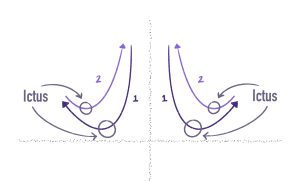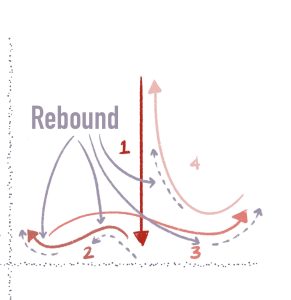2 Basic Beat Patterns and Gesture Anatomy
Lesley Mann
Learning Objectives
In this chapter, students will:
- Learn, practice, and conduct three simple beat patterns: 2/4, 3/4, and 4/4
- Explore and perform three aspects of gesture anatomy: Prep, Ictus, Rebound
Contextual Knowledge
A Kinesthetic Representation of Sound:
Conducting, at it’s most basic, is an effort to represent aural images with physical movement. We take musical ideas such as the cyclical repetition of beats (measures) and create a pattern of movement to represent those ideas. Our traditional conducting patterns represent three things:
- Tempo
- The length of the measure, as indicated by the chosen pattern
- Expressivity
- Dynamics, Articulation, Phrasing, etc.
Time Signatures:
As a starting point, musicians most typically look to the time signature, or meter, to determine a conducting pattern. We can classify all meters according to their subdivision; simple time subdivides into two, while compound meter subdivides into three. We’ll start with the three most common simple time meters, 2/4, 3/4, and 4/4.

The top number determines the pattern in a vast majority of cases, though tempo or expressive factors can sometimes lead to exceptions. A very fast triple meter, for instance, is sometimes “felt” in one, and therefore conducted with only one beat per measure. For now, we’ll operate under the assumption that the top number equals the conducting pattern. We’ll discover how and when to break this rule in subsequent chapters. (In music, rules always have the capacity to be broken!)
Beat Patterns
Each beat pattern begins the cycle with a characteristic downward movement of the arm, the downbeat, and ends the cycle with an upward movement of the arm, or the upbeat. If there are more than two beats in the meter, then additional horizontal movements are added to represent them. The beat patterns are shown below in symmetry so that, to begin with, you can conduct with both hands, a practice known as mirroring. Mirroring is only considered best practice in certain specific circumstances; it is not a default practice. To start, however, its useful to understand how the hands work together, and that the pattern is presented symmetrically, rather than in parallel movement. (Hands move in or out, rather than both to the right or left) Note, also, that the hands should never cross while mirroring, as this will inhibit the clarity of the gesture.
The 2 Pattern for Two Hands:

The 3 Pattern for Two Hands

The 4 Pattern for Two Hands

Anatomy of Gesture
Each beat in a pattern is comprised of three separate movements which add clarity to the gesture: The Ictus, The Rebound, and the Preparatory Beat (The Prep).
The ICTUS is the change in direction that is interpreted by an ensemble as the actual beat. The quality of the ictus can be rounded or pointed to display expressive qualities. The ictus is typically seen at the tips of the fingers or the tip of the baton. The conductor can utilize multiple hinges (Shoulder, elbow, wrist) to change directions. Basic timekeeping most often utilizes the elbow hinge. We’ll explore expressive decisions regarding hinges in chapter 7.



The REBOUND is the movement immediately following the ictus point, and is typically one-third to one-half the size of the ictus. The notable exception to the size is the final beat in the measure, which is fairly large as it must return to the starting point of the downbeat.



The PREP comes before the Ictus, and it is essentially the rebound of the prior beat.
The prep, ictus, and rebound combine to give form and clarity to the beat pattern.

Identify the Anatomy of Gesture: Pin the Ictus on the Pattern
Drag the labels at the bottom of the image to the correct place on the pattern to check your knowledge.
Listen to the following songs (a snippet will suffice). Identify the meter as having 2, 3, or 4 beats, and practice conducting in the appropriate pattern. While it’s not always possible to tell from listening alone whether something is notated in 2 or 4, make an informed decision about why you would choose 2 or 4.
Basic Beat Patterns Competency Check
With your teacher, demonstrate the following competencies in each of the simple patterns: (2/4, 3/4, 4/4)
- Pattern maintains a steady tempo
- Hand position maintains the palm facing down
- The pattern moves in the correct direction with fluidity between beats
- Each component of each beat is clearly discernible (Prep, Ictus, Rebound)
Gesture Anatomy Final Reflection Assignment
Submit through your Learning Management System (Canvas, Blackboard, etc):
Select a piece of music you’re working on in an ensemble setting or studying in another class such as music history or theory. Find two versions on youtube where you can see a front view of the conductor. Write a brief reflection:
- Include links to the two videos you selected.
- Compare/Contrast their use of Prep/Ictus/Rebound
- Which conductor seems to embody the music more? Why?

